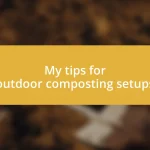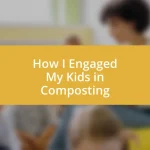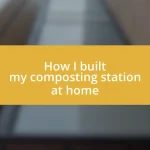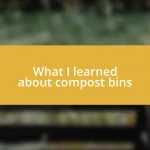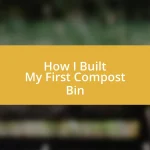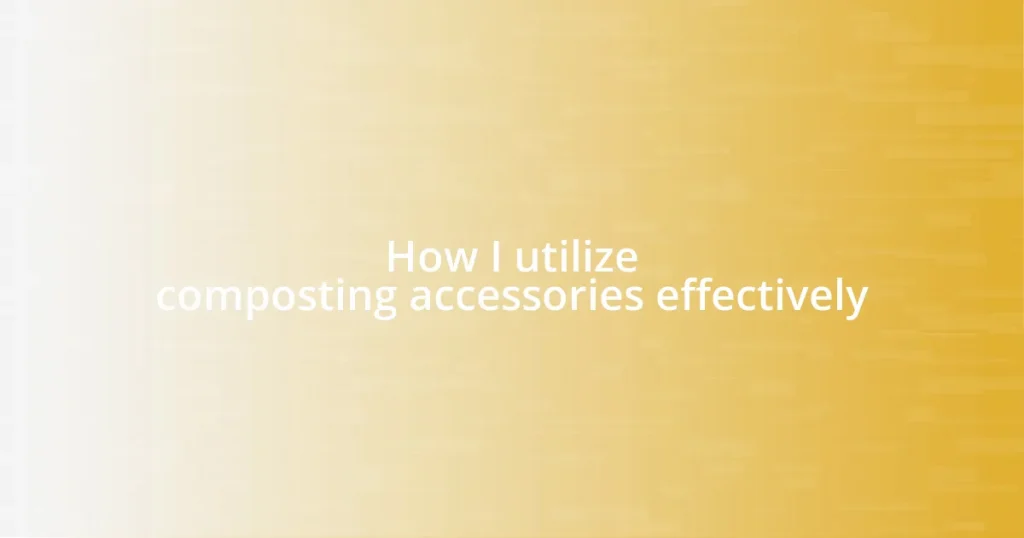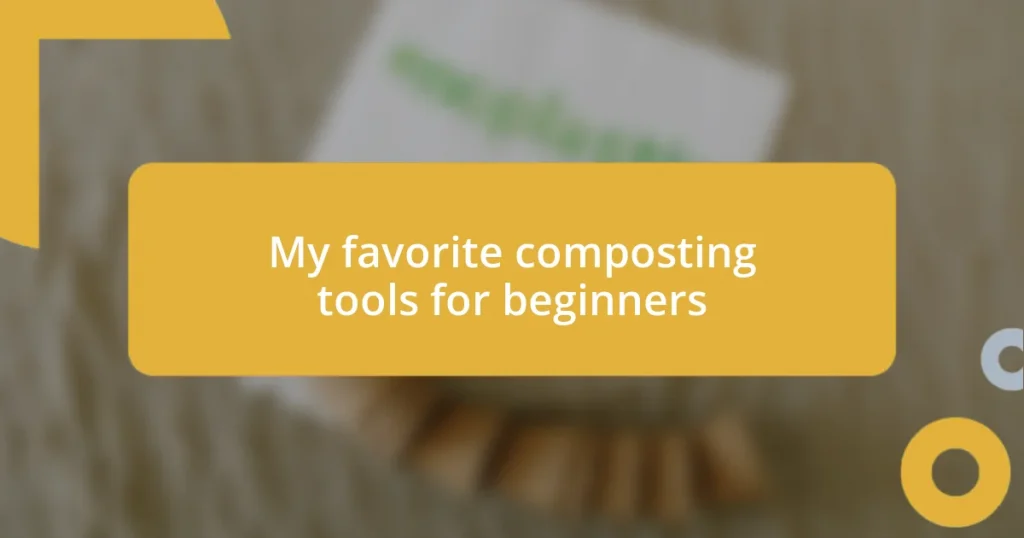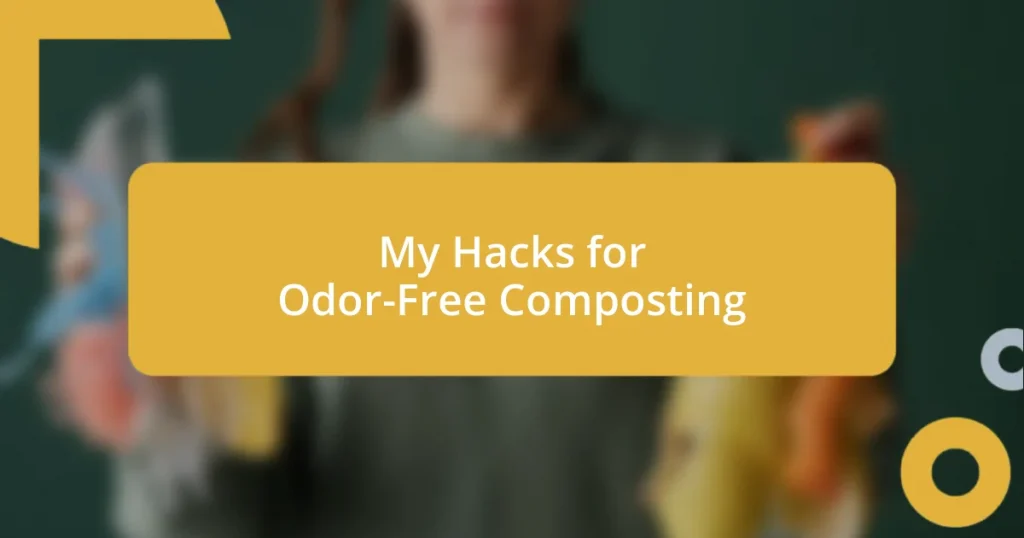Key takeaways:
- Hot composting accelerates decomposition, transforms kitchen waste into nutrient-rich compost, and enhances garden health while reducing carbon footprint.
- Successful hot composting requires balancing nitrogen-rich greens and carbon-rich browns, maintaining optimal moisture and temperature levels through regular monitoring and turning.
- Finished compost enriches soil, enhances plant growth, and represents a sustainable approach to recycling organic matter, fostering a healthier ecosystem.

Understanding Hot Composting Benefits
Hot composting offers significant advantages that can transform how we think about waste and recycling. I remember the moment I first uncovered a beautifully rich pile of compost in my backyard. The sight of it, dark and crumbly, made me realize just how effective hot composting is in speeding up the decomposition process, delivering nutrient-rich compost in a fraction of the time compared to traditional methods. Isn’t it incredible to think that with the right balance of materials, you can harness the power of heat to break down organic matter so efficiently?
One of the most rewarding aspects of hot composting is how it minimizes waste. When I first started composting, I was shocked by how much kitchen waste went into my trash—things like vegetable peels, eggshells, and coffee grounds. Now, seeing those same scraps transform into something that nourishes my garden feels not just practical but fulfilling. Have you ever considered how much potential is hiding in your waste?
In my experience, hot composting also creates a healthier environment for soil and plants. I’ve noticed that my garden flourishes with the rich nutrients from my compost, leading to vibrant flowers and bountiful vegetables. Isn’t it gratifying to see the direct impact of your efforts on the ecosystem, all while actively reducing your carbon footprint? It’s a cycle that brings joy and responsibility together in the most beautiful way.

Essential Materials for Hot Compost
When it comes to successful hot composting, the right materials are crucial. Each ingredient plays a unique role in ensuring the process generates heat and breaks down efficiently. I learned through trial and error that balancing nitrogen-rich (green) and carbon-rich (brown) materials is the key to fueling the composting fire, so to speak.
- Nitrogen-rich materials (Greens): Kitchen scraps like vegetable scraps, fruit peels, grass clippings, and coffee grounds. I always find it satisfying to toss in those vibrant fruit peels; they bring life and energy to the mix.
- Carbon-rich materials (Browns): Dried leaves, straw, wood chips, and shredded paper. There’s something almost meditative about layering these browns, giving the compost structure and aeration.
- Water: Essential for keeping the pile moist. I’ve often splashed some water on my heap, watching the steam rise; it feels like I’m encouraging a living creature to thrive.
- Air: Turning the pile regularly introduces oxygen, which is vital. Poking and turning my compost has become a little ritual; it’s almost like giving it a good massage!
Finding that perfect balance of materials not only accelerates decomposition but also nurtures a thriving ecosystem within your compost. It’s a rewarding journey of learning what works and what doesn’t, as I’ve discovered over many weekends spent tending to the pile in my backyard.

Maintaining Optimal Temperature Levels
Maintaining the right temperature in a hot compost system is essential for maximizing decomposition. I’ve found that keeping the internal temperature between 130°F and 160°F (54°C to 71°C) not only speeds up the process but also helps eliminate pathogens and weed seeds. When I first started composting, I was amazed by how just a few degrees could mean the difference between a thriving compost pile and a smelly mess.
I usually use a compost thermometer to check temperature levels, and it’s fascinating to see how my pile reacts based on the materials I add or the weather outside. For instance, after adding a hefty layer of grass clippings one summer afternoon, my pile heated up rapidly, and I couldn’t help but feel a sense of accomplishment. Have you tried monitoring your compost temperature? The moment those numbers hit the sweet spot, it feels like you’re unlocking the magic of composting.
Additionally, turning my compost pile regularly not only aerates it but also helps in maintaining the temperature levels. Each time I turn it, I feel a wave of satisfaction as I sense the heat radiating from within. It’s like I’m nurturing a small ecosystem that’s alive with potential, a vivid reminder of the transformation happening right before my eyes.
| Action | Temperature Impact |
|---|---|
| Add Greens | Increases temperature due to nitrogen boost |
| Add Browns | Helps stabilize temperature and balance |
| Turn the Pile | Redistributes heat and adds oxygen |
| Check Moisture | Maintains optimal heat generation |

Monitoring Moisture Content Effectively
Monitoring moisture content is a crucial aspect of hot composting that I’ve had to learn the hard way. I remember one weekend when I added a big batch of kitchen scraps but neglected to check the moisture levels. Within days, my pile developed that unmistakable fuggy smell of anaerobic decomposition. The moment I realized this, I knew I had to act fast, and that experience taught me the importance of keeping an eye on moisture.
To keep your compost balanced, aim for a moisture level similar to that of a damp sponge. I often use my hands to squeeze a handful from the center of the pile, and if water drips out, it’s time to add more browns, like dried leaves or straw, to soak it up. Isn’t it interesting how such a simple test can ensure that all the biological magic happens optimally? The sense of control I feel when I manage moisture levels is immensely rewarding.
I also keep a spray bottle handy for those unexpectedly dry spells. Just a few spritzes can rejuvenate a parched pile before it has a chance to stress out. When I observe the compost coming back to life, it feels like I’m watching a nature documentary in my backyard—alive, vibrant, and constantly changing. That’s the beauty of hot composting: it teaches you to be attentive to the needs of your ecosystem, just as life itself demands.

Turning Compost for Aeration
Turning my compost is an enlightening experience, one that bridges the gap between the science of decomposition and the joy of hands-on gardening. I remember when I first tackled the task—using a pitchfork to aerate my pile felt daunting but incredibly satisfying. I could almost hear the sigh of relief from the microbes as I exposed them to fresh air, revitalizing their habitat. Have you ever felt that rush of energy from just a simple act like turning a pile?
What stands out to me is the transformation that happens after each turn. The once-compact materials shift, releasing heat that escapes like a warm hug. I can visually see the change in texture; the dark, rich compost emerging from the depths invites a sense of pride in my effort. This aspect of hot composting isn’t just maintenance; it’s a partnership with nature. The physicality of turning fuels my passion, reminding me that the act itself contributes as much to the outcome as the ingredients I carefully select.
In addition to providing much-needed oxygen, turning the compost helps achieve an even mix of materials, which is vital for a successful anaerobic process. I’ve discovered that the more I turn, the better my compost thrives. It’s fascinating to witness the rapid breakdown of materials, often within just a couple of weeks. So, when I’m out there turning the pile under the sun, I find myself wondering—how did I ever manage without this connection to my compost? It has enriched my gardening experience in ways I never expected.

Troubleshooting Common Hot Compost Issues
Sometimes, you might encounter an issue where your compost pile isn’t heating up as expected. I faced this last summer when my pile seemed stagnant despite my best efforts. I remember old kitchen scraps were piled high, but the temperature barely budged. After doing some research, I learned that I had too many greens without enough browns to balance things out. Adding shredded paper and dried leaves made a world of difference; it’s fascinating how the right combination can reignite that thermal action!
Another common issue is pests infiltrating your compost pile. Once, I found unexpected visitors—ants marching proudly in and out of my bin. It made me wonder if I had done something wrong. I realized that a layer of browns on top not only helps with balance but also serves as a barrier to deter pests. Have you ever considered how a simple preventive measure can keep your compost drama-free?
Lastly, let’s talk about pile odor. A smelly pile is more than just a nuisance; it can be disheartening. When I once encountered a foul smell, I took a step back and evaluated my process. It turned out I had added too many wet materials without balancing them out. Quickly adding layers of dry browns and turning the pile alleviated the issue, transforming that icky scent into a rich, earthy aroma. Isn’t it remarkable how piecing together the right elements can bring harmony back to your composting journey?

Finalizing and Using Finished Compost
After weeks of turning and tending, there comes a moment when your compost is finally ready to be used. I remember the first time I sifted through my finished compost—it felt like uncovering treasure in my own backyard! The dark, crumbly goodness promised to enrich my garden. That feeling of anticipation, knowing my plants would thrive, was indescribable. Have you ever experienced that sense of achievement when you realize you’ve created something so useful from scraps?
Using finished compost is where the magic truly happens. I often sprinkle it onto my vegetable beds, and you can see how the plants reach for that nourishing boost. It’s similar to giving them a warm hug of nutrients. I once mixed some compost into my potting soil, and the seedlings leapt to life in a way I had never witnessed before. There’s something gratifying about watching nature respond positively to your hard work, don’t you think?
As I incorporate the finished compost into my garden, I can’t help but admire how it enhances soil structure and moisture retention. Each handful seems to breathe life into the earth. I’ve even started using it in my potted plants, and the contrast in growth is astonishing. Composting is more than just recycling; it’s a commitment to healthier soil and a sustainable garden. How rewarding is it to know that with each application, you’re not only feeding your plants but also giving back to the environment?



